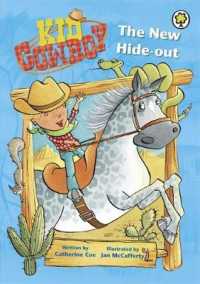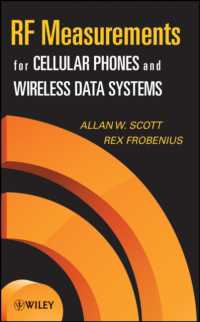Full Description
Dos mundos, a best-selling program for Introductory Spanish known for its exceptional progressive activities, made its name as an innovative pioneer in Beginning Spanish. Today, it has maintained the spirit of innovation through many successful editions and continues to be implemented in numerous beginning Spanish language classes across the nation with outstanding results.
Based on the communicative approach, Dos mundos stresses the use of engaging activities in a natural and spontaneous classroom atmosphere. The Actividades de comunicacion play a primary role in Dos mundos, since the core of the program is communication. These activities include fresh, practical ideas from the field of second-language teaching. In this research-based approach to learning language, the development of communicative language skills is the central goal, with formal grammar presentation and practice at the service of communication. To this end, the grammar explanations and exercises on the blue pages at the end of each chapter are designed for quick reference and ease of study.
Additionally, cultural content is integrated throughout each chapter. The new Conozca section on each chapter opener gives an introduction of the country or region of focus, including information about holidays, foods, famous people, and important cities. Ventanas culturales readings focus on community, customs, and daily life while Ventanas al pasado readings focus on aspects of the social, cultural, or political history of the Spanish-speaking world The Enlace readings explore literature, music, and cinema, and the Lecturas present topics such as sports and leisure activities.
Contents
(Note: The preliminary chapters (Paso A-C) and Capitulo 1 of this Table of Contents provide a comprehensive listing of contents for those chapters, as representative of the other chapters. Capitulo 2-15 provides only the vocabulary topics and grammatical structures.)
The following lists the Enlace readings found in each chapter: Capitulo 1 Enlace a la musica Cuba Capitulo 2 Enlace a la musica
La musica andina Capitulo 3 Enlace al cine
Mexico y Espana Capitulo 4 Enlace a la literatura
"Versos sencillos" Jose Marti Capitulo 5 Enlace a la musica
El rock en espanol Capitulo 6 Enlace a la literatura
"Cuadrados y angulos" Alfonsina Storni Capitulo 7 Enlace a la literatura
"Cuando salimos de El Salvador" Jorge Argueta Capitulo 8 Enlace a la literatura
"Jitomates risuenos" Francisco X. Alarcon Capitulo 9 Enlace a la musica
La musica infantil Capitulo 10 Enlace a la literatura
"Dos cuerpos" Octavio Paz Capitulo 11 Enlace a la musica
La danza negra en Peru Capitulo 12 Enlace al cine
Argentina y Chile Capitulo 13 Enlace a la literatura
"Nada mas" Maria Elena Walsh Capitulo 14 Enlace a la literatura
"Kinsey Report No.6" Rosario Castellanos Capitulo 15 Enlace a la literatura
"La noche buena" Tomas RiveraPaso A La clase y los estudiantes Actividades de comunicacionLos nombres de los companeros de clase¿Quien es? Los colores y la ropaLos numeros (0-39) Los saludosGramaticaA.1 Naming and Describing: The Verbs llamar and llevarA.2 Spelling: The Spanish AlphabetA.3 Identifying People and Things: Subject Pronouns and the Verb ser A.4 Identifying People and Things: GenderA.5 Responding to Instructions:Commands Paso B Las descripciones Actividades de comunicacionHablando con otrosLas cosas en el salon de claseLos numeros (40-69) El cuerpo humanoLa descripcion de las personasGramaticaB.1 Addressing Others: Informal and Polite you (tu/usted)B.2 Expressing Existence: hay B.3 Describing People and Things:NegationB.4 Describing People and Things: Plural Forms B.5 Describing People and Things: Adjective-Noun Agreementand PlacementPaso C Mi familia y mis amigos Actividades de comunicacionLa familia¿Que tenemos? Los numeros (10-100) y la edadLos idiomas y las nacionalidadesGramatica C.1 Expressing Possession: The Verbs tener and ser de (l) C.2 Expressing Possession: Possessive Adjectives C.3 Expressing Age: The Verb tener C.4 Describing People: Adjectives of Nationality C.5 Talking about Habitual Actions: Present Tense of Regular -ar VerbsCapitulo 1 Los datos personales y las actividadesActividades de comunicacion y lecturasLas fechas y los cumpleanosDatos personales: El telefono y la direccion Ventanas culturales
Nuestra comunidad: Rigoberta MenchuEnlace a la musica
CubaLa horaLas actividades favoritas y los deportesVentanas al pasado
Diego Rivera y Frida KahloEn resumenLectura: La pasion por los deportesGramatica1.1 Counting: Numbers 100-1000 and Dates 1.2 Talking about Habitual Actions: Present Tense of -er and -ir Verbs1.3 Asking Questions: Question Formation 1.4 Telling Time: Hours and Minutes 1.5 Expressing Likes and Dislikes: gustar + Infinitive Capitulo 2 Mis planes y preferencias Actividades de comunicacionLos planesLas clasesLas preferencias y los deseosEl tiempoGramatica2.1 Expressing Future Plans: ir + a + Infinitive 2.2 Sequencing: Ordinal Adjectives 2.3 Stating Preferences and Desires: preferir and querer + Infinitive 2.4 Describing the Weather: Common Expressions2.5 Pointing Out People and Objects: Demonstrative AdjectivesCapitulo 3 Los lugares y las actividades Actividades de comunicacionLas actividades diariasLas tres comidasLos lugares¿De donde es usted? Gramatica3.1 Talking about Habitual Actions: Present Tense of Regular Verbs3.2 Using Irregular Verbs: haver, salir, jugar3.3 Referring to Objects Already Mentioned: Direct Object Pronouns lo, la, los, and las3.4 Asking and Answering Questions3.5 Talking About Location and Origin: estar + en, ir + al / a la and ser deCapitulo 4 La vida diaria y los dias feriadosActividades de comunicacionLos dias feriados y las celebracionesLa rutina diariaLos estados fisicos y animicos Gramatica 4.1 Discussing Habitual Actions: Verbs with Stem-Vowel Changes (ie, ue) in the Present Tense 4.2 Discussing Habitual Actions: Irregular Verbs 4.3 Describing Daily Routine: Reflexives 4.4 Ordering Events: Infinitives after Prepositions 4.5 Describing States: estar + Adjective and tener + Noun Capitulo 5 Las clases y el trabajo Actividades de comunicacionLas actividades de la clase de espanolLas habilidadesLas carreras y las actividades del trabajoLas actividades futurasGramatica 5.1 Indicating to Whom Something is Said: Indirect Object Pronouns with Verbs of Informing 5.2 Expressing Abilities: saber and poder + Infinitive5.3 Referring to Actions in Progress: Present Progressive 5.4 Expressing Obligation and Duty: tener que, deber, necesitar, hay que, es necesario 5.5 Expressing Plans and Desires: pensar, quisiera, me gustaría, tener ganas de Capitulo 6 La residencia Actividades de comunicacionEl vecindario y la casaLas actividades en casaLas actividades con los amigosLas presentacionesGramatica 6.1 Making Comparisons of Inequality: mas/menos 6.2 Making Comparisons of Equality: tan/tanto 6.3 Talking about Past Actions: Preterite Tense of Regular Verbs (Part 1) 6.4 Knowing People, Places, and Facts: conocer and saber 6.5 Referring to People Already Mentioned: Personal Direct Object Pronouns Capitulo 7 Hablando del pasado Actividades de comunicacionMis experienciasLas experiencias con los demasHablando del pasadoGramatica 7.1 Talking About Past Actions:Preterite Tense of RegularVerbs (Part 2) 7.2 Relating Past Events (Part 1): Verbs with Irregular Preterite Forms 7.3 More About Relating Past Events (Part 2): Stem-Changing Verbs in the Preterite 7.4 Reporting the Past: Indirect Object Pronouns with decir 7.5 Expressing ago: hacer + Time Capitulo 8 La comida Actividades de comunicacionLas comidas, las bebidas y la nutricionLa compra y la preparacionde la comidaLos restaurantesGramatica 8.1 Referring to Objects Already Mentioned: Impersonal Direct Object Pronouns lo, la, los, and las 8.2 More about Expressing Likes: The Verbs gustar and encantar 8.3 Making Negative Statements and Questions: No, never 8.4 Expressing one or you: The Impersonal se 8.5 Using Stem-Changing Verbs like pedir and servir: Present Tense and Preterite Forms Capitulo 9 La ninez y la juventud Actividades de comunicacionLa familia y los parientesLa ninezLa juventudGramatica 9.1 Describing Family Relationships: The Reciprocal Reflexive Verbs parecerse and llevarse bien 9.2 Expressing for, from, to whom: Prepositions + Pronouns 9.3 Saying What You Used to Do: The Imperfect Tense 9.4 Describing the Past: The Imperfect and Preterite of "State" Verbs9.5 Saying What You Were Going to Do: The Imperfect Tense of ir + a + Infinitive Capitulo 10 Nuestro planeta Actividades de comunicacionLa geografia y el climaLos medios de transporteLa ecologia y el medio ambienteGramatica 10.1 Saying What You Have Done: The Present Perfect 10.2 Exclamations with ¡Que... !, ¡Cuanto/a/os/as... ! 10.3 Expressing by, through, Destination and Time (Part 1): por and para 10.4 Describing Actions: Adverbs 10.5 Expressing Reactions: More Verbs like gustar Capitulo 11 De viaje Actividades de comunicacionLos viajes en automovilEn busca de sitiosLos planes de viajeLos sitios turisticosGramatica 11.1 Giving Instructions: Polite Commands 11.2 Softening Commands (Part 1): The Present Subjunctive following querer 11.3 Expressing Indefinite Future and Present Subjunctive of Irregular Verbs11.4 Talking About Past Actions in Progress: Imperfect Progressive 11.5 Saying What Was Happening: The Imperfect in Contrast to the Pre
terite Capitulo 12 La salud y las emergencias Actividades de comunicacionEl cuerpo humano y la saludLas enfermedades y su tratamientoLas visitas al medico, a la farmacia y al hospitalLos accidentes y las emergenciasGramatica 12.1 Expressing Existence: haber 12.2 Expressing Changes in States: Become, get 12.3 Making Requests: Indirect Object Pronouns with Commands and the Present Subjunctive 12.4 Adverbs Relating Unplanned Occurrences: se 12.5 Narrating Past Experiences: Present Perfect, Imperfect, and PreteriteCapitulo 13 De compras Actividades de comunicacionLos productos y los materialesLos preciosComprando ropaLas compras y el regateoGramatica 13.1 Describing People and Things: Adjectives Used as Nouns 13.2 Indicating Which Ones(s): Demonstrative Pronouns 13.3 Talking about Price, Beneficiary, and Purpose: por and para (Part 2) 13.4 Exchanging Items: Indirect Object Pronouns 13.5 Referring to People and Things Already Mentioned: Using Indirect and Direct Object Pronouns Together Capitulo 14 La familia y los consejos Actividades de comunicacionLa familia, las amistades y el matrimonioLas instrucciones y los mandatosLas ordenes, los consejos y las sugerenciasLa crianza y el comportamiento Gramatica 14.1 Expressing each other: Reciprocal Nouns14.2 Describing: ser and estar 14.3 Giving Direct Commands: Polite and Informal 14.4 Using Softened Commands: The Subjunctive Mood 14.5 Saying Let/Have Someone Else Do It!: ¡Que + Subjunctive! Capitulo 15 El porvenir Actividades de comunicacionEl futuro y las metas personalesCuestiones socialesEl futuro y la tecnologia: Posibilidades y consecuenciasGramatica 15.1 Talking about the Future: The Future Tense 15.2 Talking about When: The Subjunctive in Time Clauses 15.3 Adding Details and Expressing Why and How: More Uses of the Subjunctive 15.4 Expressing Opinions and Reactions: Indicative and Subjunctive 15.5 Hypothetical Reactions: The Conditional15.6 If Clauses and the Past Subjunctive








